

Excess fat accumulation around the knees could concern those looking to enhance their leg’s appearance. Extra weight, sagging skin, or recent weight loss might cause fat accumulation in your knee area.
Something you might overlook during your weight loss journey is achieving a toned knee appearance.
While losing overall body fat is essential, ignoring your knee fat might make your body look disproportionate.
A decrease in muscle tone from a sedentary lifestyle or injury can also affect the appearance of the knee.
You do not need to do thousands of squats or run marathons daily. The confusion about which exercise could specifically tone your knees can be overwhelming.
Let’s look at some of the best strategies to target knee fat and understand how excessive knee fat could impact overall health.
Knee fat is the fatty tissue gathered around the patella or kneecap. It may cause bulging knees and make them appear out of shape and disproportionate.
Various factors could influence fat accumulation around the knee area. These may include weight gain, genetics, age, or hormonal influences.
Despite efforts to sustain a healthy diet and regular exercise routine, some people may struggle to reduce excess fat from their knees.
You could lose this knee fat by targeting your overall legs, maintaining a calorie deficit, and exercising regularly.

Running is a cardiovascular exercise that could help burn calories. It may also be beneficial for building stamina and endurance. Research suggests that running and jogging work the legs more intensely than walking. It may contribute to the strengthening of the front area around the knees.
High-Intensity Interval Training (HIIT) is a dynamic fitness workout that combines bodyweight exercises and resistance training. It could promote the development of lean muscle mass.
HIIT may offer a full-body workout by targeting core muscles, arms, and legs through intense intervals. It may also involve sprint interval workouts and cycling intervals.
Recent studies have demonstrated that HIIT is an effective method for burning calories and fat while building lean muscle mass. It typically consists of short bursts of high-intensity exercise followed by brief rest periods for recovery.
Squats are a fundamental lower body exercise that may target the quadriceps and glutes. They may aid in leg muscle toning and strength development. Squats engage lower limb muscles and help strengthen them by reducing fat and developing muscles.
How To Perform Squats:
Increasing nutrient-dense foods in your diet, such as fruits, vegetables, fiber-rich foods, and lean proteins, could support weight management. These foods provide essential minerals and vitamins, which may lead to weight loss, including the knees.
Including sources of monounsaturated fats like avocados and olive oil may also be beneficial for fat loss. These healthy fats could contribute to satiety and improved body composition.
Monitoring liquid calorie intake may also be an essential strategy in managing overall weight loss, including the knees.
Pilates involves controlled movements that emphasize strength-building and flexibility exercises. It could promote overall balance and physical functionality.
Pilates includes specific exercises such as hip circles and straight leg stretches focusing on the hips, inner thighs, and core muscles. These movements could help tone and strengthen the leg muscles, contributing to fat loss in the knee area.
Pilates is often recommended for people recovering from back or knee injuries. Its effective movements may help rebuild strength, flexibility, and muscle control.
To tone your knee area, it is essential to watch over your carb and calorie intake. Focus on reducing calorie consumption through total calorie restriction or time-restricted eating. Maintaining a caloric deficit of 500 calories over a day has been found to result in weight reduction.
Research has demonstrated that restricting carbohydrates could impact fat loss while preserving lean muscle mass.
Reduce your processed carbohydrate consumption, like white bread and rice, while adding whole grains, such as oats and brown rice, into the diet.
Lunges may serve as an effective exercise for strengthening and toning the quadriceps. They could contribute to overall leg muscle development, including the knee area and glutes.
Ensuring correct form during lunges is vital for maximizing their effectiveness. Maintaining a 90-degree angle when stepping forward and keeping the upper body straight helps target the quadriceps and glutes efficiently.
Including different types of lunges in your routine could also prevent muscle adaptation and plateauing. Reverse lunges, or walking lunges, may also help engage other muscle fibers and enhance overall leg muscles.
Jumping rope is a dynamic and high-calorie burning exercise that may tone and strengthen the leg muscles, including those around the knee area.
However, jumping with slightly bent knees is important to avoid joint strain upon landing. Opt for jumping on rubber surfaces instead of concrete or asphalt to minimize impact on the knees.
Due to the high-blow nature of jumping rope, it is advisable to limit each session to a few minutes to protect the knee joints.
Walking is a low-impact exercise that may help reduce body fat and tone lower-body muscles. Adding regular walks to your routine could be a simple way to enhance overall health and fitness levels.
Walking may help strengthen and tone muscles in the legs, including the quadriceps, hamstrings, and calves, which could reduce knee fat and improve knee health.
Make sure you stand tall with your shoulders back, engage your core muscles, and take natural strides to avoid unnecessary knee stress. Start with a slow rate and gradually increase the speed and distance as your fitness levels improve.
Riding a bike is a cardiovascular exercise that may help tone various leg muscles. It could also target the quads, thighs, and calves, which might contribute to toning the knee areas. This low-impact activity is particularly advantageous for people dealing with knee pain or leg injuries, providing an alternative to high-impact exercises like running.
Non-invasive procedures like cryolipolysis (CoolSculpting), mesotherapy, laser therapy, light therapy, and radiofrequency therapy could be considered. These procedures could target specific areas of fat, including the knees, to help achieve desired results without surgery.
Seeking advice from a doctor or cosmetic surgeon may provide valuable insights into personalized treatment options for reducing knee fat. These professionals can assess individual needs and recommend suitable procedures.
Must Visit: How To Lose Fat Without Losing Muscle? [7 Effective Ways]
Excess fat accumulation around the knees poses significant health risks, as it is closely associated with obesity. Extra body fat surrounding the knees may also lead to mobility issues. It serves as a known precursor to various severe medical conditions such as:
Knee fat could be a cause of a lot of factors, and reducing it involves a multifaceted approach.
If you want to lose fat around your knees, try exercises that target your legs, like lunges, pilates, jumping rope, or walking.
Creating a low-calorie deficit and consuming carbs-rich foods may also aid in weight loss. In case the traditional methods don’t work, non-invasive treatments like cryolipolysis or mesotherapy could be an option. However, consulting with a doctor before making significant lifestyle changes is essential.
Tyler Read earned an undergraduate academic degree from Sonoma State University, California and is a certified personal trainer (CPT) with NASM (National Academy of Sports Medicine). With over 16 years of experience, Tyler has trained clients both online and in-person.
He is passionate about helping others turn their love for fitness into a career. Tyler has worked with many local and commercial gyms before establishing his successful private personal training business, which he continues to operate.
